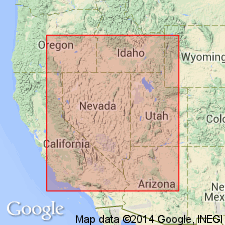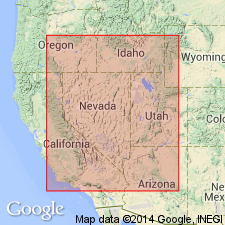
- Usage in publication:
-
- Paris Peak Member
- Modifications:
-
- First used
- Overview
- Dominant lithology:
-
- Dolostone
- AAPG geologic province:
-
- Wasatch uplift
- Great Basin province
Summary:
First published use as basal member of Fish Haven Dolostone (redescribed) in western UT and southeastern ID, Great Basin province and Wasatch uplift. Informally named in Ph.D thesis by Keller (1963). Type section is in saddle north of Paris Peak [for which unit probably named], southwestern Bear Lake Co, ID in Bear River Range. Measured section in Tony Grove Lake area in Bear River Range, northeastern Cache Co, UT and in Lakeside Mountains area, northeastern Tooele Co, UT. Consists of grayish-black to dark-gray, very finely to medium crystalline dolostone; medium to thick bedded; weathers from dark gray to medium dark gray. Average thickness about 130 ft. Overlies Swan Peak Formation; underlies Deep Lakes Member (first used) of Fish Haven. Age in north-central UT probably late Late Ordovician based on fossil corals. [Authors state in several places that unit was informally named by Keller (1963). Though authors refer to unit formally, they do not state their intention to formalize it.]
Source: GNU records (USGS DDS-6; Denver GNULEX).

- Usage in publication:
-
- Paris Peak Member
- Modifications:
-
- Revised
- AAPG geologic province:
-
- Great Basin province
Summary:
Paris Peak Member of Fish Haven Dolomite remeasured at Lakeside Mountains section of Budge and Sheehan (1980). Lakeside Mountains section is located near Delle, UT, in NE1/4 SE1/4 sec 32, T2N, R8W, Tooele Co, Great Basin province. Paris Peak was incorrectly described as 10 ft (3 m) thick by Budge and Sheehan (their unit 1) as they measured only upper part of unit. Remeasuring Paris Peak shows it to be 41.1 m thick. Overlies Swan Peak Quartzite; underlies Deep Lakes Member of Fish Haven. Stratigraphic chart. Late Ordovician (Cincinnatian) age.
Source: GNU records (USGS DDS-6; Denver GNULEX).
For more information, please contact Nancy Stamm, Geologic Names Committee Secretary.
Asterisk (*) indicates published by U.S. Geological Survey authors.
"No current usage" (†) implies that a name has been abandoned or has fallen into disuse. Former usage and, if known, replacement name given in parentheses ( ).
Slash (/) indicates name conflicts with nomenclatural guidelines (CSN, 1933; ACSN, 1961, 1970; NACSN, 1983, 2005, 2021). May be explained within brackets ([ ]).

